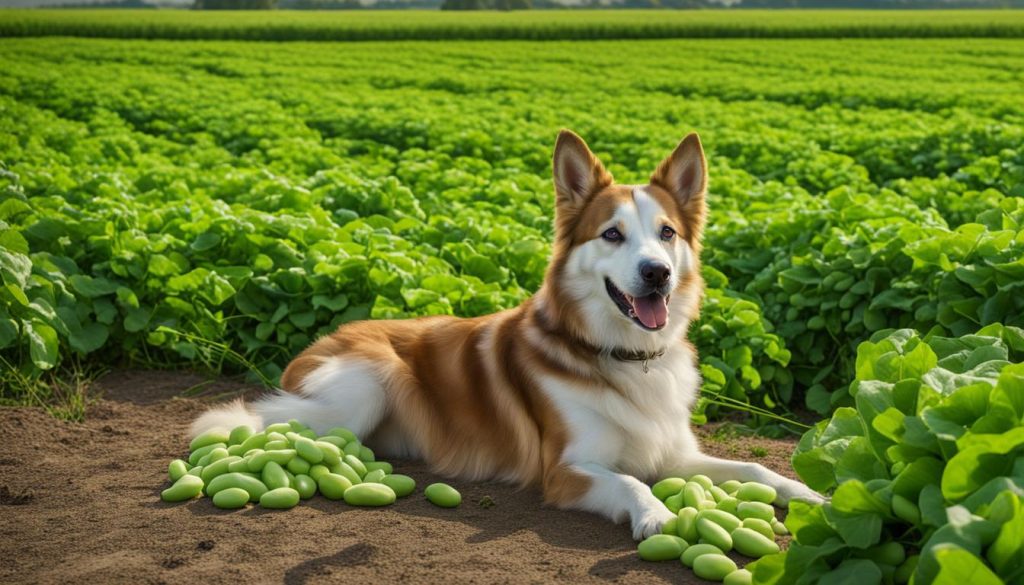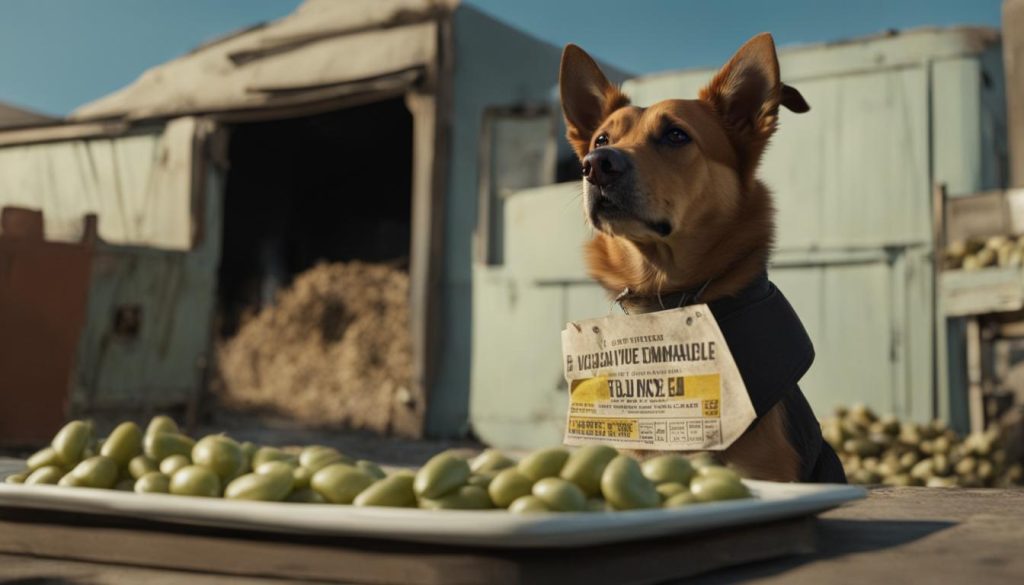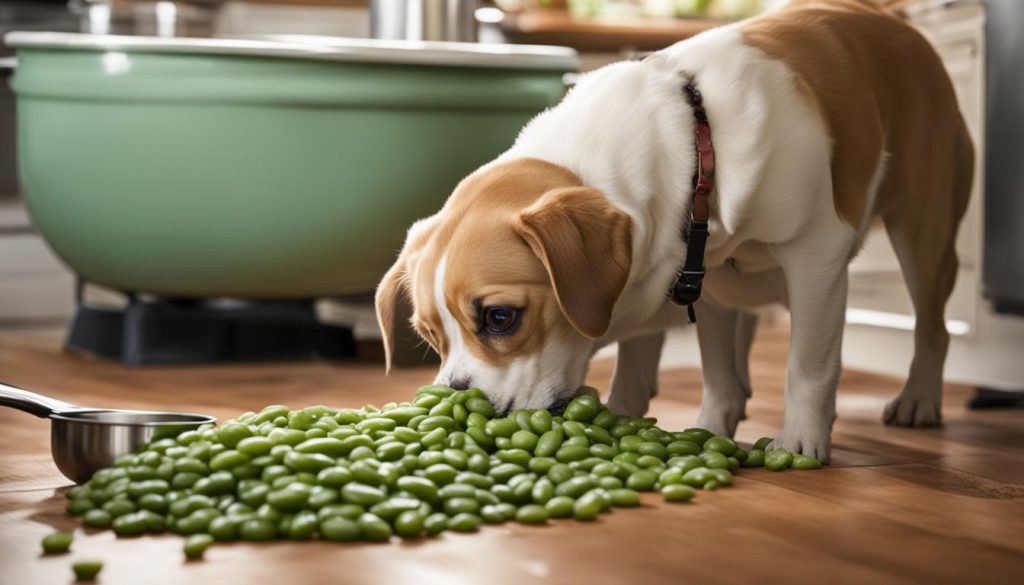Welcome to my comprehensive health guide on whether dogs can eat lima beans. As a professional journalist specializing in pet nutrition, I will provide you with all the information you need to know about feeding lima beans to your furry friend. So, let’s dive in!
Lima beans, also known as butter beans, are safe for dogs to eat in moderation. They offer a range of health benefits and can be a valuable addition to their diet. However, there are some important considerations to keep in mind to ensure your dog’s well-being.
Lima beans are a great source of plant-based, fat-free protein and are rich in carbohydrates, fiber, minerals, and vitamins. They can provide a nutritious boost to your dog’s meals, but it’s crucial to avoid canned lima beans. Canned varieties may contain preservatives, seasoning, or added sodium that can upset your dog’s stomach.
Instead, opt for dried lima beans that have been soaked and cooked without any additional ingredients. This ensures that your dog receives the full nutritional benefits without any potential harm. Lima beans can be served as a healthy snack or blended with meat and rice to create a homemade meal for your dog.
However, it’s always a good idea to consult with a veterinarian before adding lima beans to your dog’s diet. They can provide tailored advice based on your dog’s individual needs and health conditions.
Key Takeaways:
- Lima beans are safe for dogs to eat in moderation, providing plant-based protein and essential nutrients.
- Avoid canned lima beans due to potential additives that can upset your dog’s stomach.
- Opt for dried beans that have been soaked and cooked without any seasonings or additional ingredients.
- Consult with a veterinarian before introducing lima beans to your dog’s diet.
- Monitor your dog’s reaction to lima beans and adjust serving sizes accordingly.
The Health Benefits of Lima Beans for Dogs

Lima beans offer a range of health benefits for dogs, making them a valuable addition to their diet. These nutritious legumes are an excellent source of protein, which is essential for muscle maintenance and growth in dogs. Protein from plant-based sources, like lima beans, can complement the animal proteins found in commercial dog food, providing a well-rounded nutrient profile.
In addition to protein, lima beans are rich in fiber, which promotes healthy digestion in dogs. The fiber content in lima beans can help regulate bowel movements, prevent constipation, and maintain gastrointestinal health. This is especially beneficial for dogs with sensitive stomachs or digestive issues. By incorporating lima beans into their diet, dog owners can support their pet’s overall digestive well-being.
Lima beans are also low in sugar, making them a suitable choice for dogs with dietary restrictions or weight management needs. An excessive intake of sugar can contribute to weight gain and the development of health issues, such as diabetes. By incorporating low-sugar options like lima beans, dog owners can provide a healthy and satisfying snack for their furry companions.
The Health Benefits of Lima Beans for Dogs:
- High in protein, essential for muscle maintenance and growth
- Rich in fiber, promoting healthy digestion and preventing constipation
- Low in sugar, suitable for dogs with dietary restrictions or weight management needs
| Protein content | Fiber content | Sugar content |
|---|---|---|
| Approximately 14g per cup | Approximately 8g per cup | Negligible |
As with any new food, it is important to introduce lima beans gradually into a dog’s diet and monitor their response. While lima beans are generally safe, individual dogs may have specific dietary needs or sensitivities. If any adverse reactions occur, such as digestive upset or allergic symptoms, it is advisable to consult with a veterinarian.
Overall, the health benefits of lima beans, including their protein content, fiber richness, and low sugar levels, make them a dog-friendly food choice. By incorporating lima beans into their pet’s diet in the appropriate portion sizes, dog owners can support their furry friends’ overall health and well-being.
References:
– American Kennel Club. (n.d.). Can Dogs Eat Beans? Retrieved from https://www.akc.org/
– BowWow Times. (2021). Can Dogs Eat Lima Beans? Retrieved from https://www.bowwowtimes.com/
Guidelines for Feeding Lima Beans to Dogs

When it comes to feeding lima beans to dogs, it’s important to follow a few guidelines to ensure their safety and well-being. Here are some key recommendations:
- Opt for dried beans: Instead of canned lima beans, which may contain additives, preservatives, and added sodium, choose dried beans that have been soaked and cooked without any seasonings. This will provide a healthier option for your furry friend.
- Control the serving size: The recommended serving size of lima beans for a medium-sized dog is approximately 20-30 grams (2-3 tablespoons) per serving. For small to medium-sized dogs, limit the serving size to 10-15 grams (1 tablespoon). Keeping the portion size in check will help prevent any digestive issues.
- Moderation is key: While lima beans are safe for dogs, it’s important to feed them in moderation. Ideally, limit the intake to 2-3 times per week to ensure a balanced diet and to prevent any potential adverse effects.
- Consult with a veterinarian: Before introducing lima beans or any new food into your dog’s diet, it’s always a good idea to consult with a veterinarian. They can provide personalized advice based on your dog’s specific needs, dietary requirements, and any potential health concerns.
By following these guidelines, you can safely incorporate lima beans into your dog’s diet and provide them with a nutritious and enjoyable treat. Remember, each dog is unique, so it’s essential to monitor their reaction and adjust the feeding regimen accordingly. With proper care and attention, your furry friend can enjoy the benefits of lima beans as part of a well-rounded diet.
Table: Pros and Cons of Feeding Lima Beans to Dogs
| Pros | Cons |
|---|---|
| Lima beans are a good source of plant-based protein. | Some dogs may be allergic to lima beans. |
| They are high in fiber, which aids digestion. | Excessive consumption can lead to digestive upset. |
| Lima beans provide essential vitamins and minerals. | Canned lima beans may contain additives and sodium. |
| They can complement a dog’s diet when fed in moderation. | Not suitable for dogs on prescription diets. |
Potential Risks of Feeding Lima Beans to Dogs

While lima beans are generally safe for dogs, it is important to be aware of potential risks associated with their consumption. Each dog is unique and may have different dietary needs, health conditions, and preferences, so it is crucial to monitor their reaction to lima beans and consult with a veterinarian if any adverse symptoms occur.
One potential risk is that some dogs may be allergic to lima beans. Allergic reactions can manifest as itching, rashes, swelling, or gastrointestinal issues. If a dog shows any signs of an allergic reaction after eating lima beans, it is important to discontinue feeding them and seek veterinary advice.
Another risk is that excessive consumption of lima beans can lead to digestive upset. Dogs may experience gas, bloating, or diarrhea if they consume too many beans. It is essential to feed lima beans to dogs in moderation and consider their overall diet to avoid any digestive issues.
Potential Risks of Feeding Lima Beans to Dogs:
| Risk | Symptoms |
|---|---|
| Allergic reaction | Itching, rashes, swelling, gastrointestinal issues |
| Digestive upset | Gas, bloating, diarrhea |
It is also important to note that dogs on prescription diets should not be fed any food or treats outside of their prescribed diet without consulting a veterinarian. Additionally, always check with your veterinarian before making any significant changes to your dog’s diet, including the introduction of lima beans.
“While lima beans can be a healthy addition to a dog’s diet, it is essential to be aware of the potential risks and monitor any changes in their health or digestion. Consulting with a veterinarian and feeding lima beans in moderation can help ensure a balanced and safe diet for your furry friend.”
Other Beans Safe for Dogs to Eat
While lima beans are a great option for dogs, there are also other beans that are safe and healthy for them to consume. These beans can provide additional variety and nutritional benefits to a dog’s diet. Here are some other types of beans that are safe for dogs to eat:
Green Beans
Green beans, also known as string beans, are low in calories and high in fiber. They make an excellent snack option for dogs, as they are crunchy and satisfying. Green beans can be served raw or lightly steamed, and they provide dogs with vitamins A, C, and K, as well as folate and manganese.
Black Beans
Black beans are rich in antioxidants and offer a good source of fiber, potassium, and magnesium. They are a great addition to a dog’s diet as they provide plant-based protein, which can complement the animal-based proteins found in commercial dog food. It is important to cook black beans thoroughly and avoid adding any seasonings or spices.
Pinto Beans
Pinto beans are packed with protein and fiber, making them a nutritious option for dogs. They also contain antioxidants and essential minerals. It is recommended to cook pinto beans thoroughly and serve them plain to avoid any potential digestive issues or adverse reactions.
Garbanzo beans, also known as chickpeas, and kidney beans can also be added to a dog’s diet when prepared plain and served in moderation. It is important to avoid giving dogs baked beans, refried beans, chili beans, or soybeans with added ingredients that can be harmful to dogs. Always consult with a veterinarian before introducing new foods to your dog’s diet to ensure they are safe and appropriate for their individual needs.
| Bean Type | Nutritional Benefits |
|---|---|
| Green Beans | Low in calories, high in fiber, vitamins A, C, and K, folate, and manganese |
| Black Beans | Antioxidants, fiber, potassium, and magnesium |
| Pinto Beans | Protein, fiber, antioxidants, and essential minerals |
| Garbanzo Beans (Chickpeas) | Protein and fiber |
| Kidney Beans | Protein, fiber, and essential minerals |
Adding a variety of beans to a dog’s diet can provide them with essential nutrients and contribute to their overall health and well-being. However, it is important to introduce new foods gradually and monitor your dog for any signs of digestive upset or allergies. Always consult with a veterinarian before making any significant changes to your dog’s diet.
How to Safely Prepare Beans for Dogs

When it comes to feeding beans to dogs, proper preparation is key to ensure their safety and avoid any potential digestive issues. Here are some guidelines on how to prepare beans safely for your furry friend:
- Start with dried beans: Opt for dried beans instead of canned varieties, as they are free from additives and preservatives that can be harmful to dogs.
- Soak the beans: Before cooking the beans, soak them overnight to ensure they are fully hydrated. This will make them easier to digest for your dog.
- Cook without seasonings: When cooking the beans, avoid adding any seasonings, spices, or additional ingredients that may be harmful to dogs. Keep it plain and simple.
- Avoid canned beans: Canned beans often contain high sodium levels, which can be detrimental to a dog’s health. Stick to freshly cooked beans for optimal safety.
By following these steps, you can ensure that the beans you feed your dog are safe and nutritious. Always remember to introduce new foods to your dog’s diet gradually and monitor their reaction for any signs of digestive upset or food allergies. Consulting with a veterinarian before making any major changes to your dog’s diet is also highly recommended.
Table: Cooking Guide for Beans
| Type of Bean | Soaking Time | Cooking Time |
|---|---|---|
| Lima Beans | 8 hours | 60 minutes |
| Green Beans | N/A | 10-15 minutes |
| Black Beans | 8 hours | 60-90 minutes |
| Pinto Beans | 8 hours | 60-90 minutes |
| Garbanzo Beans (Chickpeas) | 8 hours | 90-120 minutes |
| Kidney Beans | 8 hours | 60-90 minutes |
Moderation and Monitoring for Digestive Upset

When it comes to feeding lima beans or any new food to dogs, moderation is key. While lima beans offer numerous health benefits, it is important to introduce them gradually and monitor for any signs of digestive upset. Dogs have different sensitivities and dietary needs, so it’s essential to tailor their diet accordingly.
Start by introducing small amounts of lima beans into your dog’s diet and observe how they react. Look out for any signs of digestive issues such as gas, bloating, or diarrhea. If your dog tolerates the beans well, you can gradually increase the serving size. However, if any adverse symptoms occur, it’s crucial to adjust the amount of beans or consult with a veterinarian.
Regular monitoring is necessary to ensure your dog’s well-being. Pay attention to their overall digestion and energy levels. If you notice any changes or concerns, it’s important to seek professional advice. A veterinarian can provide guidance tailored to your dog’s specific needs, including recommendations on serving sizes, frequency, and potential alternatives.
By practicing moderation and vigilant monitoring for digestive upset, you can incorporate lima beans into your dog’s diet in a way that promotes their health and happiness.
Consulting with a Veterinarian
When it comes to making decisions about our furry friends’ health and well-being, consulting with a veterinarian is crucial. Veterinarians have the expertise and knowledge to provide personalized recommendations based on a dog’s individual needs. They can assess a dog’s health history, current diet, and any specific health conditions or dietary restrictions that may be present.
By consulting with a veterinarian, dog owners can gain valuable insights into whether lima beans or other beans are suitable for their dog’s diet. Veterinarians can advise on the appropriate serving sizes and frequency of feeding beans, ensuring that dogs receive the nutritional benefits without any potential risks. They can also help identify any allergies or sensitivities that may be associated with feeding beans to dogs. Regular check-ups and open communication with a veterinarian are essential for maintaining a dog’s overall health and well-being.
“When it comes to introducing new foods into a dog’s diet, it’s always best to consult with a veterinarian,” says Dr. Emily Thompson, a renowned veterinarian. “Each dog is unique, and what works for one may not work for another. Veterinarians can provide personalized recommendations and address any concerns or questions dog owners may have.”
By seeking the advice of a veterinarian, dog owners can ensure that they are making informed decisions about their dog’s diet and overall care. Veterinarians are a trusted source of information and can provide guidance on how to safely introduce and incorporate lima beans or other beans into a dog’s diet. Remember, the well-being of our furry friends is always a top priority, and consulting with a veterinarian is an essential step in providing the best possible care.
| Benefits of Consulting with a Veterinarian | Why it’s important |
|---|---|
| Personalized recommendations | Veterinarians can tailor advice based on a dog’s specific needs, health history, and dietary restrictions. |
| Identification of allergies or sensitivities | Veterinarians can help identify any adverse reactions or potential risks associated with feeding beans to dogs. |
| Guidance on appropriate serving sizes | Veterinarians can advise on the ideal amount of beans to include in a dog’s diet, ensuring a balanced and nutritious intake. |
Wrapping Up
In conclusion, incorporating lima beans into a dog’s diet can provide numerous health benefits, thanks to their protein, fiber, vitamins, and minerals. However, it’s crucial to feed lima beans to dogs in moderation and prepare them safely. Avoid canned lima beans and opt for dried beans that have been soaked and cooked without any additional ingredients. Remember to consult with a veterinarian before introducing lima beans or any new food into a dog’s diet to ensure it aligns with their specific needs.
Additionally, it’s essential to monitor a dog’s reaction to lima beans and watch out for any signs of digestive upset or food allergies. Each dog is unique, so it’s crucial to tailor their diet accordingly and make adjustments as necessary. By providing lima beans in controlled portions and following proper guidelines, dog owners can offer their furry companions a balanced and nutritious diet.
While lima beans can be a healthy addition to a dog’s diet, it’s important to be mindful of potential risks. Some dogs may be allergic to lima beans or experience digestive issues when consuming them. In such cases, it’s advisable to cease feeding lima beans and consult with a veterinarian. Remember, the key to a dog’s well-being lies in open communication with a veterinarian and following their recommendations.
FAQ
Can dogs eat lima beans?
Yes, lima beans are safe for dogs to eat in moderation.
Are lima beans safe for dogs?
Yes, as long as they are prepared and served properly.
What are the health benefits of lima beans for dogs?
Lima beans are a great source of plant-based protein, fiber, and vitamins for dogs.
How should I feed lima beans to my dog?
It is important to avoid canned lima beans and cook them without any added ingredients.
Can dogs be allergic to lima beans?
Some dogs may be allergic to lima beans, so it is important to monitor their reaction.
What other beans are safe for dogs to eat?
Green beans, black beans, pinto beans, garbanzo beans, and kidney beans are also safe for dogs.
How should I prepare beans for my dog?
Soak dried beans overnight and cook them thoroughly without any seasonings or added ingredients.
How much lima beans can I feed my dog?
The recommended serving size is approximately 20-30 grams per serving for a medium-sized dog.
Should I consult with a veterinarian before feeding lima beans to my dog?
Yes, it is always recommended to consult with a veterinarian before making any major changes to a dog’s diet.






